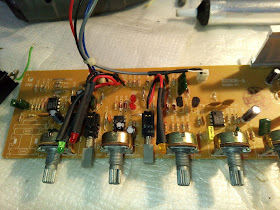This is the Randall RX20R combo guitar amplifier. It's a small combo amp that sounds big as it features a 10" Celestion-designed speaker powered by an LM1875 IC-power amp, It's got a closed-back cabinet made out of thick particleboard and plywood. It has a built-in spring reverb unit, two channels plus an Overdrive "boost" switch.
Here are its official specs:
-20 watts
-10 in. Celestion speaker
-2-channels
-Clean w/level
-Overdrive w/boost mode.
-3-band EQ
-Master Volume control
-Spring Reverb
-Headphone out
-CD/Tape Input
-12"W x 13"H x 8"D
Stock sounds:
The amp sounds Ok in its stock form but not great. There is too much fizzy treble and while the clean channel tends to get overdriven the OD channels lack a bit of gain and sensitivity which is a bad thing for a "metal"-oriented amplifier caring the "Randall" logo. This is supposed to be a high gain amplifier. There are some fender frontman models that pack much more gain than this one and this is a bit disappointing. Luckily, we can change all that!
Here's the stock sound of the rx25m model (same preamp as the RX20r):
And the sound of the same amp (different styling, same electronics/PCB) with an external 12" Eminence-loaded Epiphone cab. The tone is way better!
Modifications:
Extra gain mod
The OD channel with its boost function is Ok but as I mentioned, I expected a bit more gain and distortion to be honest. I used a Les Paul with powerful ceramic overwound humbuckers and the distortion was still a bit underwhelming. Also, the input jack was a bit faulty so I had to open the amp to replace it anyway.
Increasing the gain of the preamp could lead to muffled and muddy tones and that's not what we want to achieve. It's important to remove some bass out of the guitar signal as the amp sounds way too bassy and muddy. You 'll be impressed by the amount of low end punch this little amp can produce.
So, my first job was to replace the faulty input jack that was cutting out.
-Then, I replaced the C1 4.7nF input capacitor with a 1nF one. The C7 33nF capacitor was replaced with a 10nF one. Film capacitors are better for this application but ever small ceramic ones rated for 63V will have to do. This mod will decrease the bass frequencies a bit and provide you with clearer, less muddy tones.
-To increase the overall amount of gain of the OD channel alone without messing with the clean channel, you can simply remove the R10 resistor. Just unsolder it or cut its legs.
-To increase the amount of "boost", you can replace the R11 resistor with a 2.2kOhms, 1/4W one. This will increase the gain of the boost channel. These last two mods can be done separately if you like to experiment with the OD and Boost channels.
External speaker mod
The stock speaker is suitable for bass guitar use as it has too much treble and bass. I believe this is the speaker that some bass guitar combos use as well. A guitar speaker is usually designed to boost the mid-frequencies. The amp sounds way cooler trough an external guitar cab. I've plugged this little beast to a 2X12" Celestion V30 cab and I couldn't believe my ears. It sounded way better than the stock 10" speaker.
Fitting an external speaker output jack is quite easy. I used a classic 6-legged plastic TRS (6.3mm) female Jack and mounted it to the back of the chassis as shown in the following pic:
The wiring for this jack is easy, Simply unsolder the speaker wires from the PCB of the amp and solder two wires on the "SP+/SP-" pins of the PCB where the old speaker wires were connected. Then, use the following schematic to wire the new external cab jack. Notice the small and large terminals/contacts of the Plastic Jack. It is important not to mix them up as the external speaker won't work...
Internal speaker mod
So, after connecting the external cab I heard much improvement in tone, but is there anything I can do about the internal speaker without have to replace it? Well, yes there is!
Once you've wired the external speaker output, you can install a small "crossover" filter to the internal 10" woofer that will reduce the nasty "fizzy" treble. I used a simple 1st class RC filter for this purpose. First, I soldered a 22uF/63V capacitor in series with a 27ohms/4W resistor. Then, this RC network was soldered to the plus and minus terminals of the 10" speaker. Note that the negative/ground/black side of the capacitor was connected to the black speaker wire (SP-) and its positive side was connected to the red speaker (SP+) wire.
Here's the RC network:
Cheers,
Thanos









Δεν υπάρχουν σχόλια:
Δημοσίευση σχολίου
Your comments please!